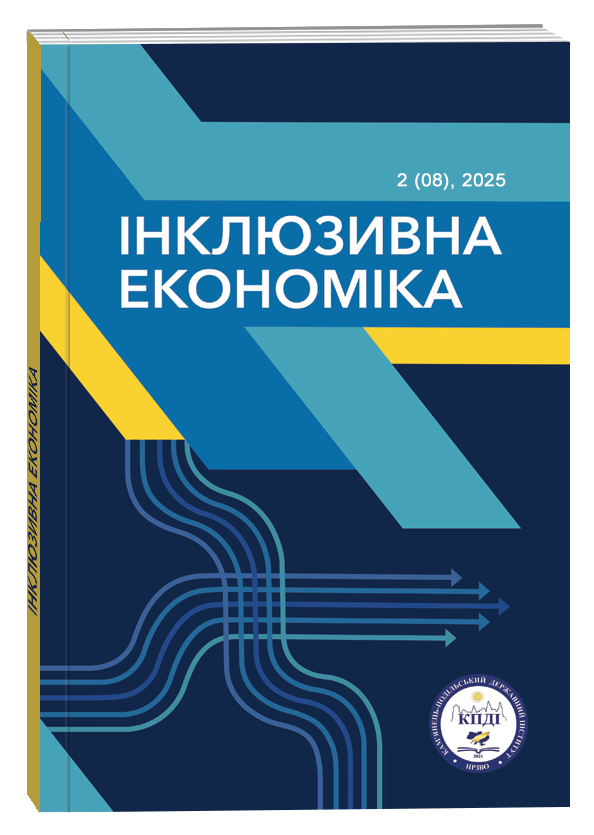INNOVATION AS A BUILDING MATERIAL FOR THE DIGITAL ECONOMY IN THE FIELD OF CONSTRUCTION
DOI:
https://doi.org/10.32782/inclusive_economics.8-2Keywords:
innovation, digital economy, business models, construction, advanced technologiesAbstract
Introduction. In today's conditions, the key role of innovation as the foundation of the digital transformation of the modern economy is determined, in particular in the context of the development of the construction industry. Innovation is not only a catalyst for growth, but also the main factor in the formation of effective business models in the digital environment. The relevance of introducing innovations in the construction sector, which currently demonstrates lower rates of innovation activity compared to other industries, is due to the specificity of products, the complexity of processes and regulatory fragmentation. Purpose. Justifying that innovation is not just a tool, but a fundamental "building material" that ensures the effective transition of the construction sector to the principles of the digital economy. Methods. Analysis of literary sources and conducting research on the development of aspects of the digital economy in the construction sector. Results. Promising areas of digitalization are identified, including building information modeling (BIM), additive technologies, automation, robotics, the use of IoT, artificial intelligence, VR/AR, and digital twins. The advantages of implementing new digital platforms and business models focused on servitization, data monetization, and the creation of collaboration ecosystems are revealed. Particular attention is paid to the circular economy as a strategic vector of sustainable development in the 21st century, which involves the reuse of resources, minimizing construction waste, and increasing the environmental responsibility of business in the construction sector. A classification of circular business models is proposed and the conditions for their implementation at domestic enterprises are outlined. The main challenges of the digital transformation of the construction industry are identified - fragmentation, the need for institutional change in corporate culture, and high investment requirements. It is summarized that successful adaptation to the digital economy is possible only if the role of innovation is reconsidered as the basis for forming new value propositions, increasing competitiveness, and achieving environmental and economic sustainability of the construction industry. Conclusion. Innovation is a key factor in the successful transition to a circular economy. It allows the creation of new products, processes and business models that contribute to the conservation of natural resources and the improvement of the quality of life. The successful implementation of innovation requires the support of governments, businesses and the public.
References
Заяць Т. А. Проблеми державного регулювання інноваційної діяльності в будівництві. Економічний простір. 2020. № 162. С. 23-29.
Згалат-Лозинська Л. О. Державне регулювання формування інтелектуально-інноваційного капіталу в будівництві. Проблеми системного підходу в економіці. 2020. Вип. 4 (78). С. 51-57.
Романова Л., Грігєрман Є. Передумови й чинники інноваційного розвитку будівельної галузі України в період війни та повоєнного відновлення. Розвиток міста. 2024. № 1. С. 95-103. DOI: https://doi.org/10.32782/city-development.2024.1-13
Banihashemi, S., Meskin, S., Sheikhkhoshkar, M., Mohandes, S. R., Hajirasouli, A., LeNguyen, Kh. Circular economy in construction: The digital transformation perspective. Cleaner Engineering and Technology. 2014. Vol. 18. DOI: https://doi.org/10.1016/j.clet.2023.100715
Mayouf M., Afsar F., Iqbal A., Javidroozi V., Mohandes S. R. Synergies between digital construction technologies in smart buildings and smartcity development to meet building users’ expectations. Heliyon. 2024. Vol. 10, № 8. DOI: https://doi.org/10.1016/j.heliyon.2024.e28585
Brozovsky J., Labonnote N., Vigren, Ol. Digital technologies in architecture, engineering, and construction. Automation in Construction. 2024. Vol. 158. DOI: https://doi.org/10.1016/j.autcon.2023.105212
Клочко А. Цифрові технології в галузі архітектури та будівництва. Управління розвитком складних систем. 2021. Вип. 48. С. 61-68. DOI: https://doi.org/10.32347/2412-9933.2021.48.61-68
Zaiats T. A. (2020). Problemy derzhavnoho rehuliuvannia innovatsiinoi diialnosti v budivnytstvi [Problems of state regulation of innovative activity in construction]. Ekonomichnyi prostir. no. 162. рр. 23-29. (in Ukrainian)
Zghalat-Lozynska L. O. (2020). Derzhavne rehuliuvannia formuvannia intelektualno-innovatsiinoho kapitalu v budivnytstvi [State regulation of the formation of intellectual and innovative capital in everyday life]. Problemy systemnoho pidkhodu v ekonomitsi. 2020. Vol. 4 (78). рр. 51-57. (in Ukrainian)
Romanova L., Hrihierman Ye. (2024). Peredumovy y chynnyky innovatsiinoho rozvytku budivelnoi haluzi Ukrainy v period viiny ta povoiennoho vidnovlennia [Prerequisites and factors of innovative development of the construction industry of Ukraine during the war and post-war recovery]. Rozvytok mista. no. 1. рр. 95-103. DOI: https://doi.org/10.32782/city-development.2024.1-13 (in Ukrainian)
Banihashemi, S., Meskin, S., Sheikhkhoshkar, M., Mohandes, S. R., Hajirasouli, A., LeNguyen, Kh. (2014). Circular economy in construction: The digital transformation perspective. Cleaner Engineering and Technology. Vol. 18. DOI: https://doi.org/10.1016/j.clet.2023.100715
Mayouf M., Afsar F., Iqbal A., Javidroozi V., Mohandes S. R. (2024). Synergies between digital construction technologies in smart buildings and smartcity development to meet building users’ expectations. Heliyon. Vol. 10, no. 8. DOI: https://doi.org/10.1016/j.heliyon.2024.e28585
Brozovsky J., Labonnote N., Vigren, Ol. (2024). Digital technologies in architecture, engineering, and construction. Automation in Construction. 2024. Vol. 158. DOI: https://doi.org/10.1016/j.autcon.2023.105212
Klochko A. Tsyfrovi tekhnolohii v haluzi arkhitektury ta budivnytstva [Digital technologies in architecture and construction]. (2021). Upravlinnia rozvytkom skladnykh system. Vol. 48. рр. 61-68. DOI: https://doi.org/10.32347/2412-9933.2021.48.61-68 (in Ukrainian)



